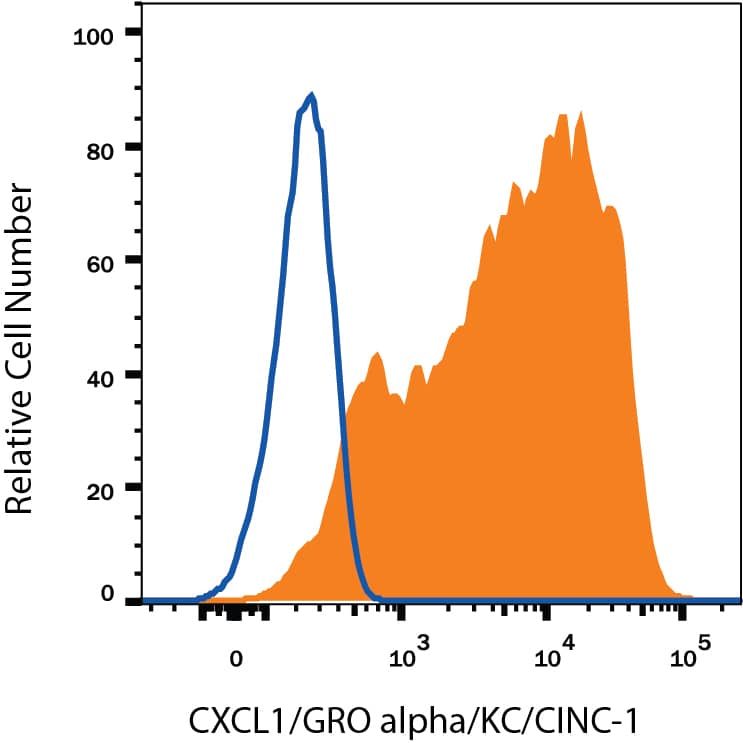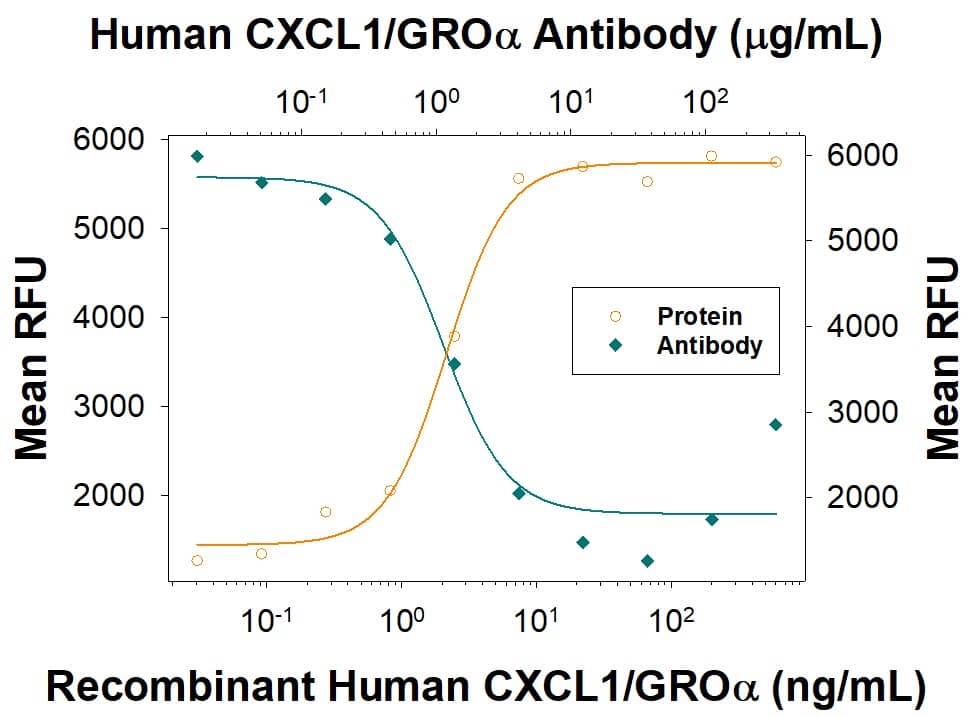Human/Primate CXCL1/GRO alpha /KC/CINC-1 Antibody Summary
Applications
Human/Primate CXCL1/GRO alpha Sandwich Immunoassay
Please Note: Optimal dilutions should be determined by each laboratory for each application. General Protocols are available in the Technical Information section on our website.
Scientific Data
 View Larger
View Larger
Detection of CXCL1/GRO alpha /KC/CINC‑1 in Human PBMCs Treated with LPS and Monensin by Flow Cytometry. Human peripheral blood mononuclear cell (PBMCs) treated with 1 µg/mL LPS for 24 hours and 3 µM monensin for 2 hours was stained with Mouse Anti-Human/Primate CXCL1/GROa/ KC/CINC-1 Monoclonal Antibody (Catalog # MAB275, filled histogram) or isotype control antibody (Catalog # MAB004, open histogram), followed by Phycoerythrin-conjugated Anti-Mouse IgG Secondary Antibody (Catalog # F0102B). To facilitate intracellular staining, cells were fixed with Flow Cytometry Fixation Buffer (Catalog # FC004) and permeabilized with Flow Cytometry Permeabilization/Wash Buffer I (Catalog # FC005).
 View Larger
View Larger
Chemotaxis Induced by CXCL1/GRO alpha and Neutralization by Human CXCL1/GRO alpha Antibody. Recombinant Human CXCL1/GROa/KC/CINC-1 (Catalog # 275-GR) chemoattracts the BaF3 mouse pro-B cell line transfected with human CXCR2 in a dose-dependent manner (orange line). The amount of cells that migrated through to the lower chemotaxis chamber was measured by Resazurin (Catalog # AR002). Chemotaxis elicited by Recombinant Human/Primate CXCL1/GROa/KC/CINC-1 (10 ng/mL) is neutralized (green line) by increasing concentrations of Human CXCL1/GROa/KC/CINC-1 Monoclonal Antibody (Catalog # MAB275). The ND50 is typically 0.600 - 9.00 µg/mL.
 View Larger
View Larger
Detection of Human CXCL1/GRO alpha/KC/CINC-1 by Functional The expression of chemokine CCL5 is up-regulated in co-cultures of BMMSCs cells and OTSCC.Co-culture of OTSCC cells with BMMSCs results in the high expression of chemokine CCL5 in HSC-3 and SAS cells, but not in dysplastic DOK cells (A). Function-blocking monoclonal antibody against CCL5 (Mab CCL5) slightly inhibits BMMSC enhanced invasion area, but has no effect on the invasion depth, whereas the antibody against CXCL1 does not increase the inhibitory effect in OTSCC invasion (B, C). Image collected and cropped by CiteAb from the following publication (https://pubmed.ncbi.nlm.nih.gov/24204919), licensed under a CC-BY license. Not internally tested by R&D Systems.
Preparation and Storage
- 12 months from date of receipt, -20 to -70 °C as supplied.
- 1 month, 2 to 8 °C under sterile conditions after reconstitution.
- 6 months, -20 to -70 °C under sterile conditions after reconstitution.
Background: CXCL1/GRO alpha/KC/CINC-1
The gene for CXCL1/GRO alpha was initially discovered in hamster cells, using subtractive hybridization techniques, as a message that is over-expressed in tumorigenic cells and in normal cells during growth stimulation. The hamster cDNA was cloned and used as a probe for the subsequent cloning of the human GRO cDNA. Independently, a cDNA encoding a secreted protein with melanoma growth stimulating activity (MGSA) was also cloned from a human melanoma cell line and found to be identical to GRO. In addition to the initially cloned GRO gene, now designated CXCL1, two additional GRO genes, GRO beta or MIP-2 alpha and GRO gamma or MIP‑2 beta, which shared 90% and 86% amino acid sequence homology, respectively, with CXCL1, have been identified. All three human GROs are members of the alpha (C-X-C) subfamily of chemokines.
The three GRO cDNAs encode 107 amino acid precursor proteins from which the N-terminal 34 amino acid residues are cleaved to generate the mature GROs. There are no potential N-linked glycosylation sites in the amino acid sequences. GRO expression is inducible by serum or PDGF and/or by a variety of inflammatory mediators, such as IL-1 and TNF, in monocytes, fibroblasts, melanocytes, and epithelial cells. In certain tumor cell lines, GRO is expressed constitutively.
Similar to other alpha chemokines, the three GRO proteins are potent neutrophil attractants and activators. In addition, these chemokines are also active toward basophils. All three GROs can bind with high affinity to the IL-8 receptor type B. It remains to be seen if a unique GRO receptor(s) also exist. The rat homolog of human CXCL1, CINC, is much more active than human CXCL1 on rat neutrophils, suggesting that this cytokine may have selective species specificity.
Product Datasheets
Citations for Human/Primate CXCL1/GRO alpha /KC/CINC-1 Antibody
R&D Systems personnel manually curate a database that contains references using R&D Systems products. The data collected includes not only links to publications in PubMed, but also provides information about sample types, species, and experimental conditions.
24
Citations: Showing 1 - 10
Filter your results:
Filter by:
-
RanBP1: A Potential Therapeutic Target for Cancer Stem Cells in Lung Cancer and Glioma
Authors: YJ Kahm, IG Kim, RK Kim
International Journal of Molecular Sciences, 2023-04-06;24(7):.
Species: Human
Sample Types: Whole Cells
Applications: Neutralization -
A patient-designed tissue-engineered model of the infiltrative glioblastoma microenvironment
Authors: R. C. Cornelison, J. X. Yuan, K. M. Tate, A. Petrosky, G. F. Beeghly, M. Bloomfield et al.
npj Precision Oncology
-
Orally-active, clinically-translatable senolytics restore alpha-Klotho in mice and humans
Authors: Y Zhu, LGPL Prata, EOW Gerdes, JME Netto, T Pirtskhala, N Giorgadze, U Tripathi, CL Inman, KO Johnson, A Xue, AK Palmer, T Chen, K Schaefer, JN Justice, AM Nambiar, N Musi, SB Kritchevsk, J Chen, S Khosla, D Jurk, MJ Schafer, T Tchkonia, JL Kirkland
EBioMedicine, 2022-03-13;0(0):103912.
Species: Human
Sample Types: Whole Cells
Applications: Neutralization -
Eutopic endometrial immune profile of infertility-patients with and without endometriosis
Authors: N Freitag, DM Baston-Bue, JS Kruessel, UR Markert, TN Fehm, AP Bielfeld
Journal of reproductive immunology, 2022-01-29;150(0):103489.
Species: Human
Sample Types: Whole Tissue
Applications: IHC -
Squamous trans-differentiation of pancreatic cancer cells promotes stromal inflammation
Authors: Tim DD Somerville, Giulia Biffi, Juliane Da beta ler-Plenker, Stella K Hur, Xue-Yan He, Krysten E Vance et al.
eLife
-
Neuronal impact of patient-specific aberrant NRXN1alpha splicing
Authors: E Flaherty, S Zhu, N Barretto, E Cheng, PJM Deans, MB Fernando, N Schrode, N Francoeur, A Antoine, K Alganem, M Halpern, G Deikus, H Shah, M Fitzgerald, I Ladran, P Gochman, J Rapoport, NM Tsankova, R McCullumsm, GE Hoffman, R Sebra, G Fang, KJ Brennand
Nat. Genet., 2019-11-29;51(12):1679-1690.
Species: Human
Sample Types: Cells
Applications: Flow Cytometry -
Adenosine A2A Receptor Blockade as an Immunotherapy for Treatment-Refractory Renal Cell Cancer
Authors: L Fong, A Hotson, J Powderly, M Sznol, RS Heist, TK Choueiri, S George, BG Hughes, MD Hellmann, DR Shepard, BI Rini, S Kummar, AM Weise, MJ Riese, B Markman, LA Emens, D Mahadevan, JJ Luke, G Laport, JD Brody, L Hernandez-, P Bonomi, JW Goldman, L Berim, DJ Renouf, RA Goodwin, B Munneke, PY Ho, J Hsieh, I McCaffery, L Kwei, SB Willingham, RA Miller
Cancer Discov, 2019-11-15;0(0):.
Species: Human
Sample Types: Cells
Applications: Flow Cytometry -
Neutrophil Activities in Human Ocular Toxoplasmosis: An In Vitro Study With Human Cells
Authors: LM Ashander, S Lie, Y Ma, E Rochet, JM Washington, JM Furtado, B Appukuttan, JR Smith
Invest. Ophthalmol. Vis. Sci., 2019-11-01;60(14):4652-4660.
Species: Human
Sample Types: Whole Cells
Applications: Neutralization -
Inhibition of IRE1 RNase activity modulates the tumor cell secretome and enhances response to chemotherapy
Authors: SE Logue, EP McGrath, P Cleary, S Greene, K Mnich, A Almanza, E Chevet, RM Dwyer, A Oommen, P Legembre, F Godey, EC Madden, B Leuzzi, J Obacz, Q Zeng, JB Patterson, R Jäger, AM Gorman, A Samali
Nat Commun, 2018-08-15;9(1):3267.
Species: Human
Sample Types: Whole Cells
Applications: Neutralization -
Tumor Microenvironment in Functional Adrenocortical Adenomas: Immune Cell Infiltration in Cortisol-producing Adrenocortical Adenoma
Authors: Y Kitawaki, Y Nakamura, F Kubota-Nak, Y Yamazaki, Y Miki, S Hata, K Ise, K Kikuchi, R Morimoto, F Satoh, H Sasano
Hum. Pathol., 2018-03-27;0(0):.
Species: Human
Sample Types: Whole Tissue
Applications: IHC-P -
CXCL1 induces senescence of cancer-associated fibroblasts via autocrine loops in oral squamous cell carcinoma
Authors: EK Kim, S Moon, DK Kim, X Zhang, J Kim
PLoS ONE, 2018-01-23;13(1):e0188847.
Species: Human
Sample Types: Whole Cells
Applications: Neutralization -
Caspase-8 Acts in a Non-enzymatic Role as a Scaffold for Assembly of a Pro-inflammatory FADDosome Complex upon TRAIL Stimulation
Authors: CM Henry, SJ Martin
Mol. Cell, 2017-02-16;65(4):715-729.e5.
Species: Human
Sample Types: Whole Cells
Applications: ICC -
Metronomic chemotherapy prevents therapy-induced stromal activation and induction of tumor-initiating cells
Authors: Kelvin K Tsai
J. Exp. Med., 2016-11-23;0(0):.
Species: Human
Sample Types: Whole Cells
Applications: Neutralization -
Nlrp12 mutation causes C57BL/6J strain-specific defect in neutrophil recruitment
Authors: Tyler K. Ulland, Nidhi Jain, Emma E. Hornick, Eric I. Elliott, Gwendolyn M. Clay, Jeffrey J. Sadler et al.
Nature Communications
-
CXCL1 expression is correlated with Snail expression and affects the prognosis of patients with gastric cancer
Authors: ZHEN XIANG, DA-PING JIANG, GUANG-GAI XIA, ZHE-WEI WEI, WEI CHEN, YULONG HE et al.
Oncology Letters
-
Human Bone Marrow Mesenchymal Stem Cells Induce Collagen Production and Tongue Cancer Invasion
Authors: Sirpa Salo, Carolina Bitu, Kalle Merkku, Pia Nyberg, Ibrahim O Bello, Jussi Vuoristo et al.
PLoS ONE
-
Neutralization of the IL-17 axis diminishes neutrophil invasion and protects from ischemic stroke.
Authors: Gelderblom M, Weymar A, Bernreuther C, Velden J, Arunachalam P, Steinbach K, Orthey E, Arumugam T, Leypoldt F, Simova O, Thom V, Friese M, Prinz I, Holscher C, Glatzel M, Korn T, Gerloff C, Tolosa E, Magnus T
Blood, 2012-09-13;120(18):3793-802.
Species: Human
Sample Types: Whole Tissue
Applications: IHC-P -
Statins Affect the Presentation of Endothelial Chemokines by Targeting to Multivesicular Bodies
Authors: Johanna Hol, Kari Otterdal, Unni M. Breland, Espen Stang, Turid M. Pedersen, Kathrine Hagelsteen et al.
PLoS ONE
-
The expression and prognostic impact of CXC-chemokines in stage II and III colorectal cancer epithelial and stromal tissue.
Authors: Oladipo O, Conlon S, O'Grady A
Br. J. Cancer, 2011-02-01;104(3):480-7.
Species: Human
Sample Types: Whole Tissue
Applications: IHC-P -
Serglycin is a major proteoglycan in polarized human endothelial cells and is implicated in the secretion of the chemokine GROalpha/CXCL1.
Authors: Meen AJ, Oynebraten I, Reine TM, Duelli A, Svennevig K, Pejler G, Jenssen T, Kolset SO
J. Biol. Chem., 2010-11-12;286(4):2636-47.
Species: Human
Sample Types: Whole Cells
Applications: ICC -
Aberrant expression of selectin E, CXCL1, and CXCL13 in chronic endometritis
Authors: Kotaro Kitaya, Tadahiro Yasuo
Modern Pathology
-
Protein chip discovery of secreted proteins regulated by the phosphatidylinositol 3-kinase pathway in ovarian cancer cell lines.
Authors: Moscova M, Marsh DJ, Baxter RC
Cancer Res., 2006-02-01;66(3):1376-83.
Species: Human
Sample Types: Whole Cells
Applications: Immunodepletion -
IL-17 enhances the net angiogenic activity and in vivo growth of human non-small cell lung cancer in SCID mice through promoting CXCR-2-dependent angiogenesis.
Authors: Numasaki M, Watanabe M, Suzuki T, Takahashi H, Nakamura A, McAllister F, Hishinuma T, Goto J, Lotze MT, Kolls JK, Sasaki H
J. Immunol., 2005-11-01;175(9):6177-89.
Species: Human
Sample Types: Cell Culture Supernates
Applications: Neutralization -
Laminar shear stress-induced GRO mRNA and protein expression in endothelial cells.
Authors: Hagiwara H, Mitsumata M, Yamane T
Circulation, 1998-12-08;98(23):2584-90.
Species: Human
Sample Types: Cell Lysates
Applications: Western Blot
FAQs
No product specific FAQs exist for this product, however you may
View all Antibody FAQsReviews for Human/Primate CXCL1/GRO alpha /KC/CINC-1 Antibody
Average Rating: 5 (Based on 1 Review)
Have you used Human/Primate CXCL1/GRO alpha /KC/CINC-1 Antibody?
Submit a review and receive an Amazon gift card.
$25/€18/£15/$25CAN/¥75 Yuan/¥2500 Yen for a review with an image
$10/€7/£6/$10 CAD/¥70 Yuan/¥1110 Yen for a review without an image
Filter by:


